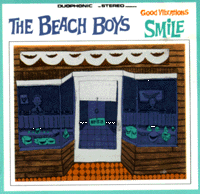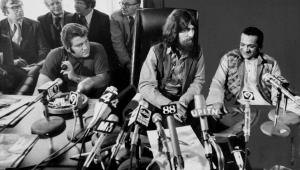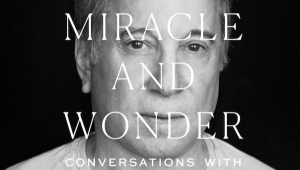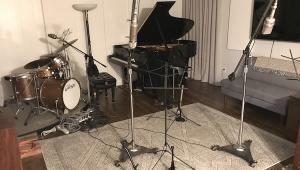Head Wondermint Discusses Taking Brian Wilson's Smile on the Road

Wondermint vocalist/vibes/keyboardist Darian Sahanaja, a member of the Wondermints—Brian Wilson's live back-up group— speaks with Matthew Greenwald about his job as Brian Wilson's "musical secretary," and about the restoration and creation of Wilson's legendary Smile album for both live and studio presentation.
Q: Can you give me a brief thumbnail of how the Smile material came to be presented live?
A: Well, from my point of view, I'm in his band, and I just kinda hear the word from the mountain, ya know, if they feel like taking on some project, I'm there 100%. But, after touring for three years - which was unprecedented, Brian Wilson on a solo tour- which came off very well, and he was comfortable with the band, it seemed logical that we take on Pet Sounds . And this was also unprecedented as well, to take on an album of that magnitude live. So we did it, and it came across very well. After we had gotten into our second year of doing Pet Sounds…after a while, it seemed like we were milking it…
Q: “The Wurlitzer effect”…
A: Yeah right, of repetition…and then people were looking at each other, management, Melinda, the whole organization…and asked, ”What next? How could we possibly top Pet Sounds? Smile was the logical step. Of course, that's easier to conceptualize than to realize. (Pause) I have to admit, when I first heard about it, I was a bit wary…
Q: Going through the original tapes…now, you, aside from being a musician in Brian's band, are also someone who has been one of the biggest Smile collectors; your job was to go through the original tapes to find what material would be used in the live performance…
A: Yes, that's what I did. I had to find as many complete, or nearly complete pieces that we could use. Basically, the objective here was to present this music live, and it's fairly well known that the album was left unfinished, and it was in a whole bunch of fragments: Brian had a version of “Heroes And Villains” here, a version of “Good Vibrations” there…so many variations.
Q: Yes, and there are Beach Boy/Smile fans who say that there were versions of “Barnyard” actually in “Heroes And Villains,” things like that…
A: Right, or “Wind Chimes”. And all this leads me to believe that he was just on a roll, going with his gut, ya know? Variation on a riff, variation on a theme…and make sense of it later. Basically he had done “Good Vibrations”, and that was done over a period of months, and he was expanding on a theme, and he didn't know where it was going to go. He was just going for something, and he'd know when it was right. I mean, there are hours and hours of just the verse of “Good Vibrations”! Different tempos, different variations, different grooves…same with the chorus. He somehow managed, in the end, to harness that and find some focus and put it all together to create the masterpiece single that we all know and love. I can't think of another case before that where a producer or composer would record things in sections like that and put it all together later, modularly.
Q: Different approach than Pet Sounds…
A: Yes, because Pet Sounds was cut traditionally - as complete performances. Smile was a totally different way of recording and composing. I like to call it 'modular composing'. It was sort of way ahead of its time, because in the late 60's and to this day, people do it like that, especially with the advent of hard disc recording.
Q: Hey, you guys - the Wondermints - have done that…on Bali.
A: Yes! Exactly; Bali was an album that took that approach to some extent. On our last album (Mind If We Make Love To You) we went more traditional. Anyway, I think Brian was ahead of his time to record that way. I see him doing “Good Vibrations” and saying, 'Wow, I'm onto something here…” And, it was a success, and 'I'm going to do a whole album like this…' But imagine, one song took about four months, and now he was going to take on a whole album in that style.
Q: With what you're describing, this way of recording, and then adding the tension within the band, the family situation, drugs, etc.…it's no wonder the record didn't get finished.
A: Exactly.
Q: Now, being a big fan/collector of the album, did you find anything that you were completely surprised at, that hadn't surfaced before on bootlegs?
A: The stuff that's leaked out on the 'unofficial circuit” pretty much covers the stuff that was archived in the vaults. Unfortunately there are some gaps in the vaults….
Q: That might lead credence to the stories that some of the tapes were in fact, destroyed…
A: Exactly. You look at Pet Sounds, and the archives there, and everything is well-documented there, and all the tapes are archived, everything is in sequence. Now, it gets to the Smile era, its 'tape, tape, missing tape, tape, missing tape, reel, three missing reels…'
Q: I think when people come and see the show, even some of the hard-core Smile collectors will have a few surprises. For one, I had never heard that beautiful Johnny Mercer song… I think it's called “I Wanna Be Around”?
A: Well, that was always titled “I Wanna Be Around/Friday Night/Workshop”
Q: What about this thing called “Look”? Was that part of “Child Is Father To The Man”?
A: That was “Look/”Song To Children”…it's part of the whole 'life-cycle' thing…”Wonderful”, “Look”, “Child Is Father To Man”, “Surf's Up”. And that seems to have a lot to do with how it was put together, in sections. Everything was there chord-wise, basic track-wise (to whatever we could find). It was more a matter of were there vocal melodies to put over some of these pieces…and were there lyrics? And that's what happened in the Fall (of 2003), getting Brian together with Van Dyke.
Q: Okay…before we get into Van Dyke contributing, how did you arrive at the final song selection for the concert presentation?
A: Well, that gets into working with Van Dyke, too. Basically, it started off as we had this monumental project ahead of us, to perform Smile in some form, live. It started out with me getting together as many of the tracks that I could find. What I did was I loaded it all into my I-Book, brought it all up to Brian's. I was using the modern technology to our advantage, because back then, Brian didn't have the luxury of being to monitor and audition things immediately.
Getting together with Brian those first few days…Brian was very scared, and here you get to that point where you inevitably get to with Brian, and this goes back to the Pet Sounds tour. Do just let him lie there and do nothing and watch T.V., and make a suggestion where nine times out of 10, he's going to say, “No, I don't wanna do that.” And then you ask yourself why he doesn't want to do it? He's either scared, or he's lazy. In the world of Brian Wilson, it's not what's right or what's wrong, it's what is the least of two evils. He's always going to be a troubled person; there's always going to be dysfunction. So in the end, it's helping him make a choice that he won't regret, or will make him feel better about himself. I mean, just touring, in general, was something he didn't really want to do. But after that first year…he made it through. And he doesn't have to do it. But you know what? He likes it! If he didn't want to do it, he either wouldn't do it… or worse, he'd sabotage it.
So here we are doing Smile, and I'm wary, but I know we're going to have to do this. I know that we can do this; I know this band can pull it off. My reservations were more 'why should we be doing this? We're dealing with myth here - we're dealing with mystique, and legacy. It's larger than life.' But here I am, with this music, on my I-Book, up in Brian's music room… with music that's reminding him of really uncomfortable times, politics, family, guilt, bad feelings, whatever So what I did was this: I looked at him and said, 'Brian, we're not trying to “finish” Smile here. But we just gotta perform this music live, so we have to figure out a way to perform this music so that it flows. Present it so that it's a nice listening experience. 'Cause it's great music that deserves to be heard.' At that point, he said, “Okay, okay”.
Q: I think that was a brilliant way to do it, Darian.
A: Yeah, and when we started playing it, it was more of Brian looking at it as just playing this music with this band, period. There was one point where we got to “Do You Like Worms”, and Brian got really excited and said, “Oh yeah! We're going to do that, and Paul Mertins can play this on that…” And from that prospective, he was really enjoying what he was hearing. But it took some time, and it was definitely 'baby steps'.
Q: How did Van Dyke get involved?
A: Well, we're right at that point here. On “Do You Like Worms”, I knew there were lyrics, because earlier, David Leaf, the man who is the ultimate archivist of all things Brian, had offered to help in any way he could, and he gave me some session sheets and other paperwork. Among these were a set of handwritten lyrics to that song by Van Dyke, which he had given to Frank Holmes, who was the designer of the original 1966 cover and booklet. And I brought them! (shows photo copy). So, you have lyrics, and here you have, 'Rock, rock, roll, Plymouth Rock roll over…' - which we know - but you also have this: 'Waving from the ocean liners - beaded cheering…” and it was amazing: Brian started singing this! But then we couldn't make some of the other words out, and Brian gets up and calls Van Dyke, and you can hear him saying, “Van Dyke, this is Brian. Do you remember that song, “Do You Like Worms”? (laughter) You can tell that he totally caught Van Dyke off guard. But he had Melinda fax the lyrics over to him, and Van Dyke emailed back, and said that the word was 'Indians'. So it was: 'Waving from the ocean liners - beaded cheering/Indians behind them…”. It was amazing, and Van Dyke had written the lyrics out on the email, and underneath, he wrote a note: “Oh yes, I had given these to my dear old friend Frank Holmes back in the day…thank God somebody had saved these, because the originals I had lost back at a house that was flooded.” So from David Leaf, to us, to Van Dyke Parks. Amazing.
So the next day, I drive up to Brian's house, and Brian's standing in front of his big house, rocking back and forth, waiting for me, and I get out of the car and say, “Hi, Brian”. “Hi Darian, how's it goin'?” “Good”. “Okay, great. Van Dyke will be here in 15 minutes.” (laughter). It was amazing. I was so happy…but more than that, if there's anyone's blessing you need on this project, it's Van Dyke Parks. He came up to Brian's many, many times, and they'd listen to stuff, and when he heard the transitions that we put in between the songs, he said, “Good…good decisions…” Boy, that made me feel good. I remember the time we were listening to the Hawaiian chant on “Do You Like Worms”, and Brian said, “Man, what a great sound! How did we do that?!” Van Dyke said, “Oh yeah, that's beautiful! It's a lap steel guitar…and a vocal.” So, a lot of it was coming back to both of them.
I have to tell you one thing that really stuck out in my mind from these sessions - you'll appreciate this. When we listened to that section I just described, Van Dyke said, “That's so…December 6th, 1941.” You know, just before the Pearl Harbor attack, and America's fascination with the Tropics. That just nailed it for me.
Q: That's beautiful. You know, I've always had a feeling that some of the greatest artists - at least the one's that I seem to have a handle on: Van Dyke, Brian, Stephen Stills, Neil Young, Fred Neil, Dylan… they seem to live in their own time consortium. I get this feeling a lot with Van Dyke and Brian, especially,
A: Absolutely…I completely agree with you all the way. You know, when Brian and Van Dyke started to work with each other in 1966, they were very much free thinkers, and at that time the whole pop culture world was becoming very British. Everyone was climbing on that Anglophile bandwagon that The Beatles had brought forth…yet here are these two guys who are American pioneers. They wanted to celebrate being American…
Q: But not in a fascist, patriotic/nationalistic way…
A: No, just more of “this is what we know and love. This is what we are - we are traditionalist.” It's interesting, but when you talk to Brian, he's not really “of the 60's.” He uses much older terminology, like from the 1920's.
Q: I always get that from Van Dyke, too. Every time I've spoken to him…
A: Oh yeah…same thing, exactly.
THE STUDIO ALBUM
Q: When I heard that you guys were going into the studio to record Smile, my initial though was that the success of this new studio project would lie in capturing the vibe of the background vocals, which may be the most difficult and intangible element.
A: Absolutely, and I was nervous. It's a little too early to tell how that's succeeding. We finished the basic tracks, which came out great…but the background vocals were what I was always concerned about. Let's face it, they had a magic blend…
Q: The human factor…
A: Exactly, the human factor; that'd good. It becomes, 'are we trying to recreate the blend of those five guys'…or are we doing 'Brian Wilson presents in 2004', and doing the best we can. And I think that's what we have to do. Those guys had a very, very special blend, and it was that sibling blend, and it was magic - those guys were magic when they sang together. You can say what you want to about Mike Love, but he sang great in that blend.
A: Oh, I completely agree. Stuff he did on “Cabinessence”, the low drone on “I Love To Say Da Da”; it's brilliant, just brilliant. To me, in regards to him, it's the things he did and said apart from the singing that were problematic. Anyway, back to what you're doing now…
A: All we can do is sing the parts that Brian came up with. I'm just trying to be there every step of the way to do things like a check, a check on the vibe. And that'll be tough, ya know, because one of the things that I have always loved about Smile was the sort of mad edge that it has. It was avante guard…it could fly off the handle at any second; and it did at times. So how do you do that? Well, I'm finding that it's a fine line between madness, cohesion and craft. So, hopefully we'll deliver something that's a good compromise.
Q: Is the studio recording going to be based on the live program - the trilogy?
A: Yeah, basically. We came up with a few ideas that Brian wanted to try out, so it's not going to be exactly like the live show. (long pause)
Here's the thing: most people, when they record an album, do it under studio conditions, and then they go out and perform it live. In this situation, it's the opposite. Most people, when they go out and perform live, they put a little more energy into it, a little more dynamic, for performance sake. So here we are with a 'script', in essence, a 'play' version of the script…now we have to go and make the movie version of the script. Now we can do 'close-up shots', and get the lighting just right. So, in a lot of ways, the recording is a little less 'rock', and a little more orchestral.
Q: What are the immediate plans?
A: Well, the studio album should be out in the Fall. We're going back to England for more shows in July, and we're going to wait a little while on American dates. Logistically, that's a very difficult thing to tackle, purely because of the size and number of venues, with the kind of show we're presenting. But there's a very good chance that we will do some shows in Japan by the end of the year.
(end)
Thank you: T. Yoshida, M. Fremer, S. Stanley, Lulu, R. Rubens,
B. Preiss, Bob of Toluca Lake, The Universal…and of course, Darian Sahanaja.
©2004 M. Greenwald
















































